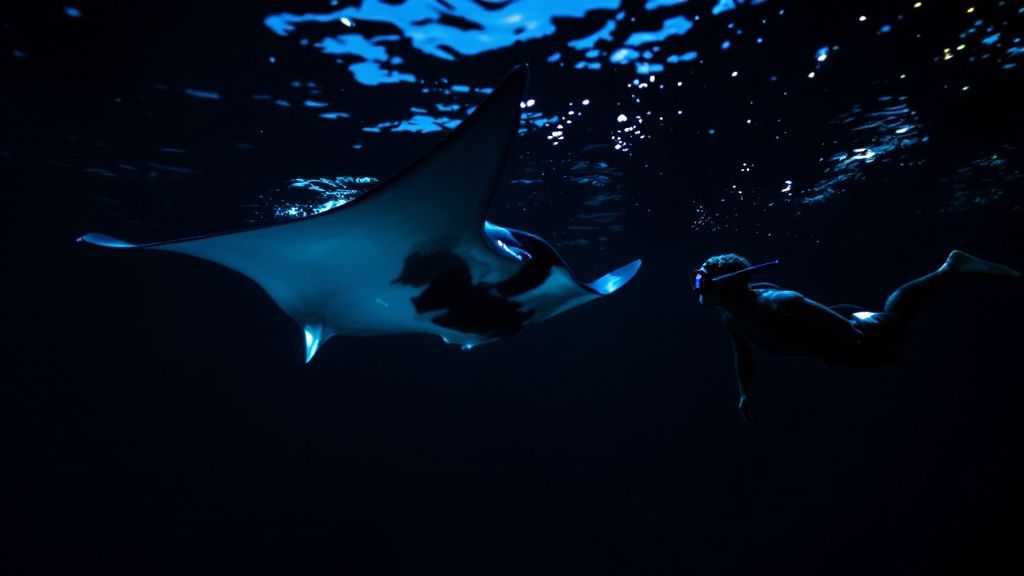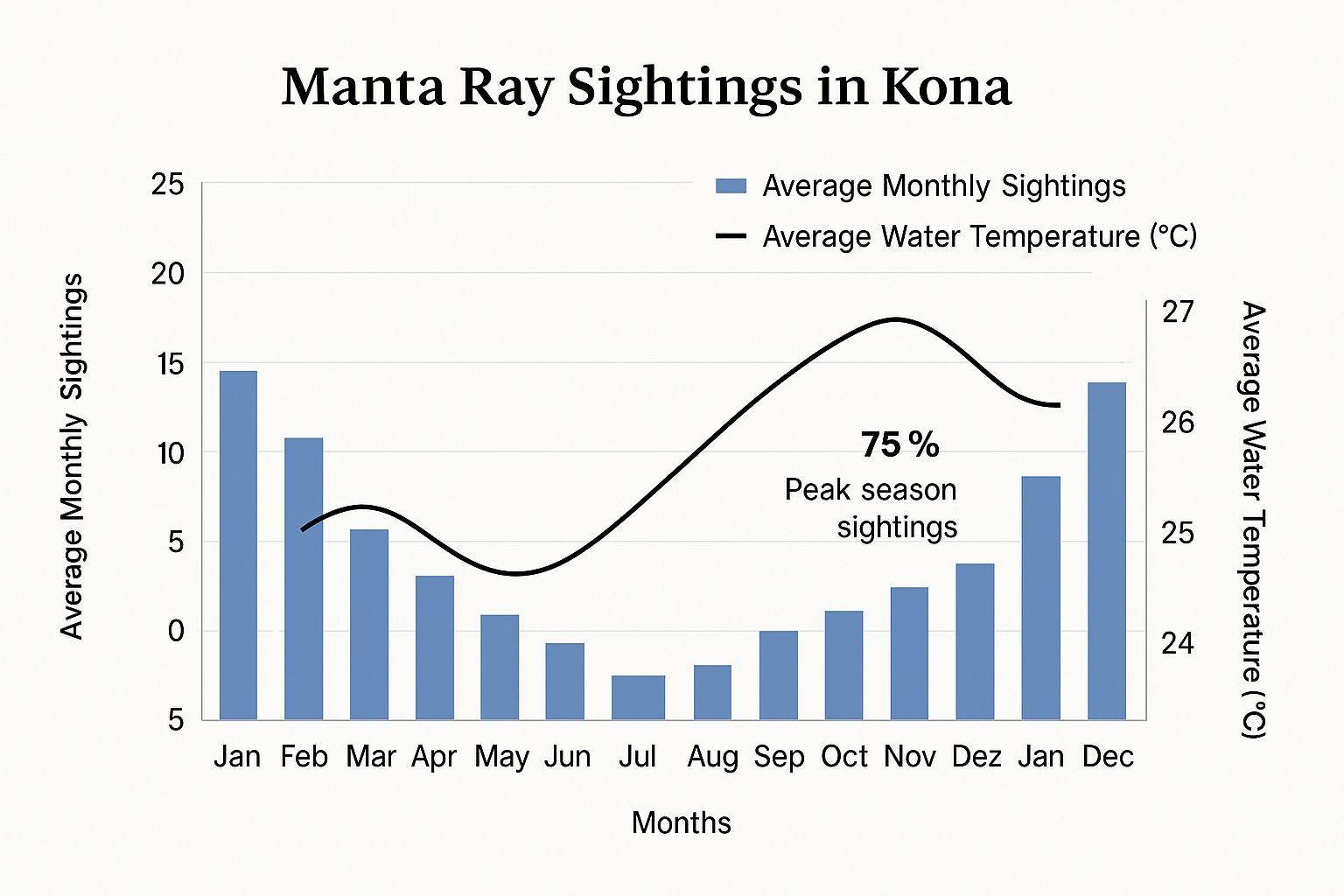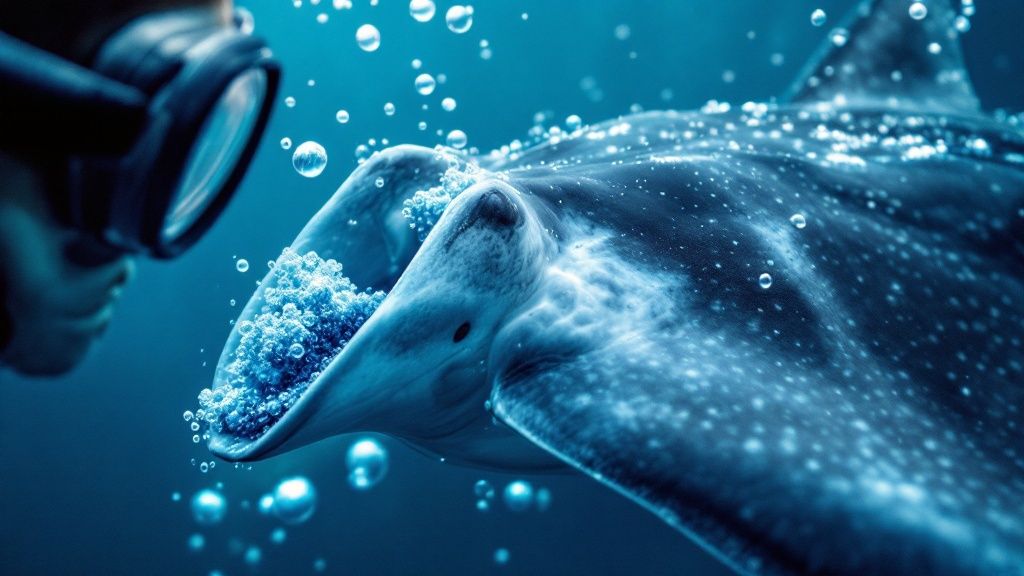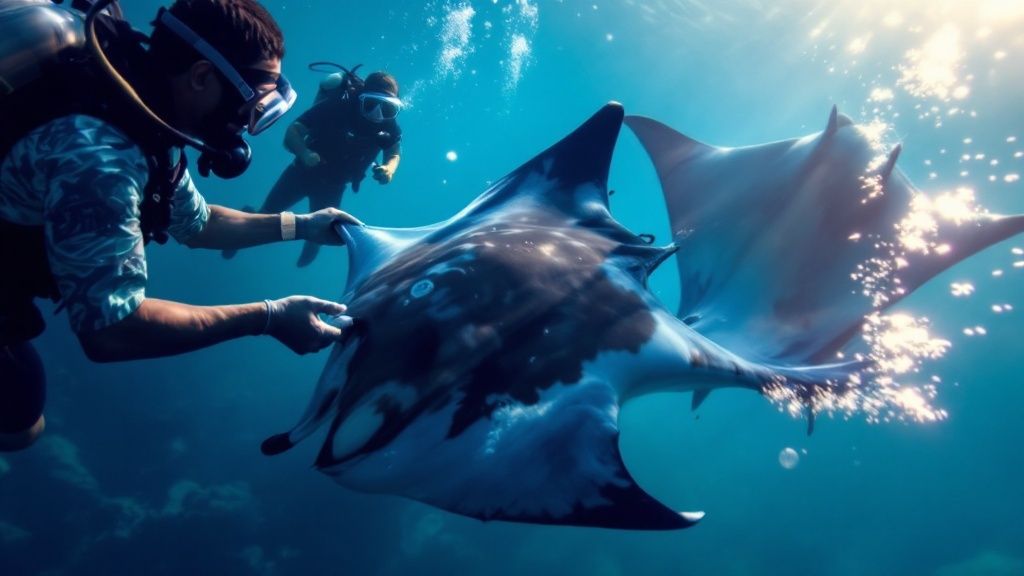Manta Ray Snorkel Kona: Hawaii's Underwater Magic Experience
- Byron
- May 24
- 11 min read
The Magic of Manta Ray Snorkel Kona
Imagine floating in the dark Pacific, illuminated only by specialized underwater lights. Suddenly, enormous manta rays, with wingspans up to 16 feet, appear as if from nowhere, gliding gracefully just below you. This is the magic of a manta ray snorkel in Kona, an experience consistently ranked among Hawaii's best wildlife encounters. It’s a truly immersive experience, connecting you with the raw power and beauty of the ocean.
Why Kona is Special for Manta Ray Encounters
The Kona Coast has been famous for decades for its consistent manta ray sightings, especially during these nighttime snorkeling adventures. This is due to the unique ecosystem; plankton, attracted by the lights, create a feast for these gentle giants. This reliability translates into an impressive sighting success rate of roughly 80% to 90%. Most participants get to see these incredible creatures. This high success rate contributes to the approximately 80,000 participants annually, highlighting the popularity of this activity. For more details, check out the: Jack's Diving Locker Manta Ray Report.
The Emotional Impact of a Manta Ray Encounter
The sheer size and grace of the manta rays leave many people speechless. Veteran guides share stories of participants emerging from the water with tears in their eyes, overwhelmed by the beauty and the profound connection they’ve experienced. It’s not simply seeing wildlife; it’s about feeling part of something much bigger than yourself. This emotional impact separates the manta ray snorkel from typical tourist activities.
Respectful Viewing Practices and Cultural Significance
The careful viewing practices developed in Kona put the manta rays’ well-being first. Snorkelers stay still at the surface, allowing the mantas to approach and perform their mesmerizing underwater ballet. Mantas also hold deep cultural significance in Hawaiian tradition, revered as graceful and intelligent beings. This respectful encounter allows visitors to connect with both nature and the rich island heritage. Experiencing these animals in their natural habitat fosters a deeper appreciation for marine conservation. The memory of these gentle giants gliding through the dark waters will stay with you long after you leave the Big Island.

Prime Locations for Unforgettable Manta Encounters
Not all manta ray viewing spots are created equal. Knowing where to go dramatically impacts your manta ray snorkel Kona experience. This section explores the legendary sites of Manta Village and Manta Heaven, revealing why these locations consistently deliver breathtaking encounters.
Manta Village and Manta Heaven: Hotspots of Activity
These two sites, just off the Kona coast, are renowned for their high concentrations of manta rays. This is due to the unique underwater topography and current patterns, which create ideal feeding grounds. For example, the ocean floor at Manta Village is relatively shallow and sandy, perfect for the plankton that attract the mantas.
Additionally, the currents bring a constant supply of these microscopic organisms, ensuring a reliable food source for the rays. Manta Heaven, similarly, boasts nutrient-rich waters and consistent currents, drawing in large numbers of plankton and, consequently, manta rays.
Manta ray sightings in Kona have been meticulously tracked since 2009. These detailed statistics help researchers understand the creatures’ movement patterns and habits. The data collected between 2009 and 2014 confirmed that locations like Manta Village and Manta Heaven are particularly favored by manta rays. This is due to their unique underwater characteristics.
These consistent sightings enrich local marine tourism and contribute to scientific knowledge about manta ray behavior. Find more detailed statistics at Manta Ray Advocates.
Understanding the Data: Peak Seasons and Water Conditions

The infographic above visualizes average monthly manta ray sightings in Kona, overlaid with average water temperature. It also highlights the peak season sighting percentage. While manta rays can be seen year-round, sightings peak between November and April. During these months, there's a 75% success rate.
This correlates with slightly cooler water temperatures, typically between 23°C and 27°C. These temperatures seem to be favored by the plankton the mantas feed on. This makes these months the ideal time for a manta ray snorkel Kona adventure.
To help you choose the best location for your manta ray adventure, we've compiled a comparison table highlighting key features of the main viewing spots:
Manta Ray Viewing Locations in Kona Comparison of the main manta ray snorkel locations in Kona, highlighting success rates, accessibility, and unique features
Location | Success Rate | Best Time | Depth | Special Features |
|---|---|---|---|---|
Manta Village | High | Year-round | Shallow | Sandy bottom, easy access |
Manta Heaven | High | Year-round | Moderate | Nutrient-rich waters, consistent currents |
Other locations | Varies | Dependent on location | Varies | Potential for more intimate encounters, less crowded |
As the table illustrates, both Manta Village and Manta Heaven offer high success rates for sightings. While Manta Village is known for its shallow, sandy bottom and easy access, Manta Heaven boasts nutrient-rich waters and consistent currents. Exploring other, less popular locations can offer a more intimate experience.
Exploring Emerging Viewing Spots
While Manta Village and Manta Heaven remain the most popular spots, savvy visitors are beginning to explore lesser-known areas. These emerging locations often offer more intimate encounters with smaller groups of manta rays. However, these sites may require more specialized knowledge of local currents and water conditions.
For those seeking a more personalized experience, consider researching these less-traveled viewing spots. Learn more about planning your manta ray snorkel Kona experience. Experienced guides are essential for exploring these areas safely and effectively. The rewards can be significant, offering a unique perspective on these majestic creatures in a less crowded environment.
Inside a Manta Ray Snorkel Tour: What Really Happens
From the moment you step off the bus to the time you're back on solid ground, a manta ray snorkel tour is a well-organized event. This section breaks down the entire process, giving you a behind-the-scenes look at these unique nighttime adventures.
Preparing for the Encounter: Briefings and Boat Journeys
Most tours start with a pre-departure briefing. Experienced guides cover important safety procedures, explain manta ray behavior, and describe how the tour will unfold. This briefing is especially helpful for those new to snorkeling with manta rays, easing any concerns and ensuring everyone feels at ease. After the briefing, it's a short boat trip to the viewing location. During the ride, guides often share interesting information about the local marine environment, highlighting the special conditions that make Kona a manta ray haven.
Entering the Water and Creating the Perfect Viewing Conditions
Once you arrive at the viewing site, guides help with equipment, showing you how to use the snorkel gear and providing wetsuits or flotation aids if needed. Entering the water is typically a gentle backward roll from the boat, minimizing disturbance and making for a smooth transition. With everyone in the water, guides deploy special lighting. These lights aren't for shining directly on the manta rays; rather, they attract plankton, the manta rays' main food. This creates an ideal viewing setting, drawing the mantas closer to the surface where snorkelers can watch them feed. You might be interested in: How to master your manta ray night snorkeling experience.
The Manta Ray Ballet: An Emotional Journey
The true magic starts as the manta rays gather. These graceful giants move effortlessly through the water, doing elegant loops and barrel rolls as they dine on plankton. This captivating spectacle evokes a wide range of emotions, from a little initial nervousness to sheer awe. Many people feel a powerful connection to these animals. The economic contribution of manta ray snorkeling in Kona is considerable, attracting numerous tourists every year. This high demand has created a booming marine tourism sector. The one-of-a-kind experience of witnessing manta rays in their environment has established Kona's manta ray snorkeling tours as the gold standard for marine wildlife encounters. Explore this topic further here. Discover the best locations for manta ray viewing by exploring established tour companies: Manta Ray Snorkel.

Addressing Concerns and Maximizing Your Viewing Experience
Water temperatures are generally pleasant, ranging from the low 70s to low 80s Fahrenheit. While you don't need to be an expert swimmer, being comfortable in the water is essential. Tours cater to different experience levels, and guides are always available to assist. They offer advice on positioning, helping you maximize viewing opportunities without disturbing these protected animals. This ensures both the participants and the manta rays enjoy a safe and rewarding experience.
Perfect Timing: When to Book Your Manta Adventure
Planning a manta ray snorkel trip in Kona? Picking the right time is essential for an unforgettable experience. It impacts everything from water clarity to the number of fellow snorkelers you'll encounter. This guide will help you navigate the seasons and other key factors.
Understanding Seasonal Impacts
Seasonal changes influence plankton levels, water visibility, and manta ray behavior. Plankton, the manta rays' main food source, flourishes under specific conditions. Shifts in water temperature and currents, for example, affect plankton blooms. This directly impacts where and when manta rays congregate to feed.
Seasonal weather also plays a role in ocean visibility. Calmer seas generally offer better visibility, giving you clearer glimpses of these graceful giants. Understanding these patterns will help you pinpoint the best time for your snorkeling adventure. You might find our ultimate guide on the best times to see manta rays in Kona helpful.
Peak Season vs. Shoulder Seasons: Finding the Right Balance
Peak tourist season, usually during the winter months, boasts more tour options. However, this often translates to larger crowds. The shoulder seasons (spring and fall) present an enticing alternative.
You may encounter fewer people and potentially better viewing conditions due to calmer waters. The trade-off? The weather can be less predictable. Carefully considering your priorities will help you decide the best time for your trip.
Beyond the Seasons: Moonlight, Currents, and Weekly Patterns
Beyond seasonal variations, other factors affect your manta ray experience. The lunar cycle, for instance, influences plankton visibility. Brighter moonlight can diminish plankton visibility, potentially affecting manta ray behavior.
Ocean currents also change throughout the year, impacting water temperature and plankton distribution. Even weekly variations, tied to local weather and tides, can shape your viewing experience. To help you understand these nuances, we've compiled a helpful table:
To help you plan your perfect manta ray snorkeling trip, we've created a handy guide outlining the typical conditions throughout the year:
Seasonal Guide to Manta Ray Snorkeling in Kona Monthly breakdown of factors affecting manta ray snorkeling experiences throughout the year
Month | Water Temp | Visibility | Crowd Level | Sighting Probability |
|---|---|---|---|---|
January | Moderate | Good | High | High |
February | Moderate | Good | High | High |
March | Moderate | Good | Medium | High |
April | Moderate | Good | Medium | Medium |
May | Warm | Variable | Low | Medium |
June | Warm | Variable | Low | Medium |
July | Warm | Variable | Low | Medium |
August | Warm | Good | Medium | High |
September | Warm | Good | Medium | High |
October | Warm | Good | Medium | High |
November | Moderate | Good | Medium | High |
December | Moderate | Good | High | High |
This table offers a general overview, and conditions can vary. Remember to check current forecasts and tour operator updates for the most accurate information.
Planning Your Trip: Considerations Beyond Manta Sightings
When planning your Kona manta ray snorkel adventure, think beyond the mantas themselves. Accommodation prices are typically higher during peak season. Consider other Big Island attractions you'd like to explore and how they fit with a nighttime manta ray excursion.
For example, a visit to Volcanoes National Park or a relaxing afternoon on one of Kona's stunning beaches perfectly complements a manta ray experience. Factoring in these additional elements ensures a truly memorable Big Island vacation.
Selecting Your Perfect Manta Ray Tour Provider
With so many tour operators offering manta ray snorkel Kona experiences, picking the right one can truly elevate your trip. Choosing wisely not only affects how well you see these magnificent creatures, but also the overall safety and enjoyment of your adventure. Let's explore the key factors to consider when selecting your provider.
Evaluating Safety and Expertise
Safety should always be your top priority. Look for operators with certified guides, well-maintained equipment, and solid safety protocols. For example, make sure the guides are certified lifeguards or hold similar qualifications, and that they provide thorough safety briefings before you enter the water.
Guide expertise is also essential. Experienced guides have a deep understanding of manta ray behavior, local currents, and the best viewing spots. This knowledge guarantees a richer, more insightful experience. To get prepared, check out these 10 Manta Ray Snorkel Tips.
Group Size, Boat Quality, and Equipment Standards
The size of your group really impacts your experience. Smaller groups allow for a more personal encounter, minimize disruption to the manta rays, and provide better opportunities to interact with your guide.
Also, consider the boat's quality. Look for vessels designed for comfort and stability. Sturdy, well-maintained boats make for a smoother, more enjoyable trip, especially in changing ocean conditions.
Finally, check that the snorkeling equipment is in good shape and fits you properly for a comfortable, leak-free experience. These seemingly small details can significantly influence your overall comfort and enjoyment.
Conservation Credentials: A Vital Consideration
Choosing an environmentally responsible operator benefits both the manta rays and your experience. Look for providers dedicated to sustainable practices, such as minimizing disruption to the manta rays' natural habitat.
Some operators are actively involved in manta ray research and conservation efforts, contributing to the long-term well-being of the manta ray population. These credentials demonstrate a commitment to responsible tourism, adding an extra layer of value to your tour.
Tour Formats: Tailoring Your Experience
Different tours cater to different preferences. Large group excursions are generally more affordable, while premium small-boat tours prioritize personalized experiences. Private charters are perfect for families or small groups looking for an exclusive encounter.
For example, photographers might prefer smaller groups, while families with young children might appreciate a larger boat with more amenities. Think about your own needs and preferences to determine the best tour format for a truly rewarding experience.
Special Considerations: Families, Photographers, and Accessibility
Families with children should choose operators who are experienced in working with younger snorkelers and who prioritize safety. Photographers will want to ensure there's enough space on board for their equipment.
They should also look for guides who can offer advice on underwater photography techniques, especially in low-light settings. Don't forget about accessibility. Some operators provide specialized services for participants with mobility limitations.
Discuss your needs with the tour provider beforehand to ensure they can accommodate any special requirements. This preparation helps create a safe, comfortable, and enjoyable trip for everyone.

Insider Techniques for a Magical Manta Ray Experience
Want to elevate your manta ray snorkel Kona adventure from simply memorable to truly extraordinary? Mastering a few insider techniques can make all the difference. These tips, gathered from professional guides, marine photographers, and seasoned snorkelers, will help you maximize this unique encounter.
Pre-Trip Preparation: Conditioning and Breathing
Before embarking on your trip, practicing basic water skills can significantly improve your comfort and confidence in the open ocean. Regular swimming builds stamina and reduces anxiety in the water. Practicing controlled breathing exercises is also highly beneficial. Mastering deep, slow breaths improves buoyancy control, allowing you to float effortlessly and conserve energy during your snorkel. This also helps prevent hyperventilation, a common issue for first-time snorkelers. For more pre-trip advice, check out our guide on essential tips for your manta ray snorkel Kona experience.
Positioning for the Perfect View
Once you're in the water, positioning is key to a great experience. Remember to stay horizontal at the surface, avoiding sudden movements that might frighten the manta rays. Position yourself slightly away from the main light source. This allows you to see the mantas illuminated against the darker water, creating a dramatic and captivating view. Avoid kicking or splashing, as this can disturb both the manta rays and your fellow snorkelers.
Underwater Photography: Capturing the Magic
Capturing breathtaking underwater photos of manta rays requires specific techniques and the right equipment. A waterproof camera with a wide-angle lens is essential for capturing the mantas' full size and grace. Using a red filter compensates for the loss of color at depth, and a flash or external strobe is vital in low-light conditions. Be mindful of other snorkelers when using your flash. Avoid aiming it directly at them, as this can be disruptive.
Overcoming Common Challenges
Many travelers combine a Manta Ray Snorkel Kona experience with other adventures. For example, you could explore Las Vegas Tours during the same trip. Common snorkeling concerns, like mask fogging, are easily addressed with anti-fog solution or a simple spit-and-rinse method. Manage water temperature with an appropriate wetsuit thickness. If you're anxious about nighttime swimming, focus on your breathing and stay close to the guide. Their presence and expertise will reassure you.
Transforming From Tentative to Confident
By mastering these insider techniques, you'll transform from a hesitant participant into a confident ocean explorer. These tips will allow you to fully immerse yourself in the wonder of this experience. Being prepared and knowledgeable enhances not only your own enjoyment but also contributes to a more respectful encounter for everyone involved, including the majestic manta rays.
Ready to experience the magic? Book your Manta Ray Night Snorkel Kona Hawaii Tours today and prepare for an unforgettable underwater adventure.
Comments